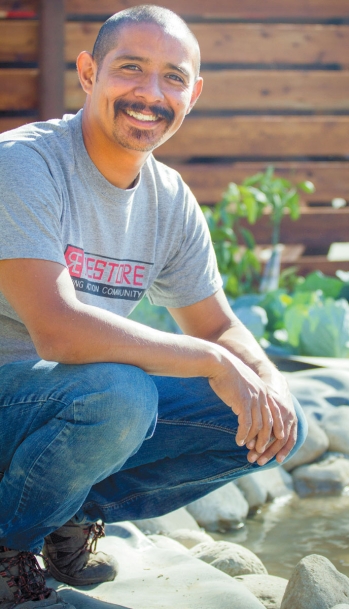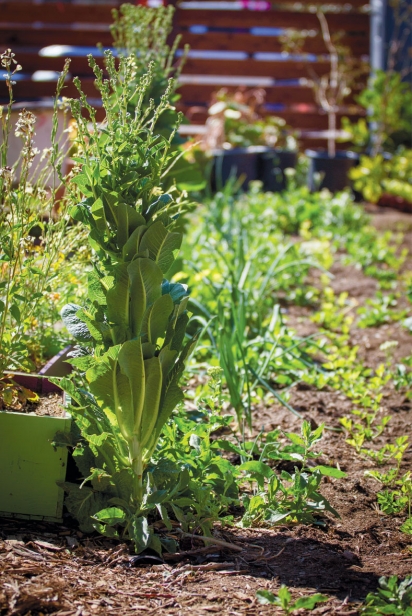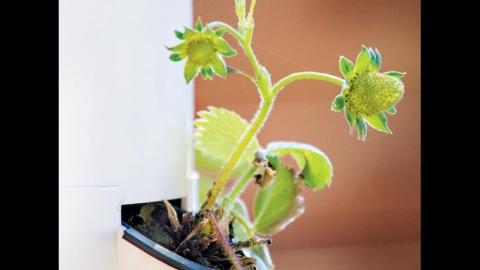If You Plant it, They Will Come
Nurturing the neighborhood through its garden
The Restore Garden on the Avenue in Ventura is like a fruited paradise: citrus, papaya, plum and apple trees grow alongside rows of celery, arugula, cabbage, zucchini, tomatoes, kale, chard and lettuce. The newly installed aquaponics pond adds atmosphere and ambient noise, while feeding nutrient-rich water to three vertical growing towers. Five chickens, six rabbits, a greenhouse and a storage unit converted into an office also fit comfortably in the backyard-size space.
Gerardo Gallegos, founder of the nonprofit Restore Ventura, started late last year, maintains and directs the garden in addition to several other projects. He’s a landscaper by trade and surfer at heart, meaning he treats Restore’s success with a modest kind of nonchalance. In other words, the transformative effect that the Restore Garden and its Kid Garden Brigade program have made on the community is no biggie, man—all in a day’s work.
The community impact is unmistakable. In the time it took me to tour the space with Gerardo and sit down for an interview, at least five friends of the garden stopped by to say hello and give the new aquaponics setup their nod of approval. When Gerardo mentioned that Restore Ventura was part of a highly relational community, he wasn’t kidding.
“You see how many people come by here?” he asks, beaming. The garden’s news is the community’s news.
To find out how Restore Ventura’s good work affects the community, I sat down with Gerardo in the garden to learn more.
How does Restore Ventura equip families in need with the tools for success?
We know what this community needs to succeed, what it’s lacking, and we seek to provide that.
It could be as easy as lending a hand with something that someone is unable to do. If it’s an elderly person, maybe it’s transportation to a doctor’s appointment. It could be someone who is low-income and in need of repairs or yardwork that they can’t do by themselves. It’s equipping the kids through the Kids Garden Brigade program, through education.
We recently helped somebody paint their house and put in a climate-appropriate landscape; now it’s not a place that someone will want to tag. People appreciate it more and respect it more.
On a good workday, we could have between 50 and 100 volunteers because they love the impact we have on the community. We like to beautify it, and people respect beautiful communities.
What inspired you to start Restore Ventura?
Initially we started out of a need that I had: to feed my family good, wholesome, organic food. The cost of food is high, so we started growing our own food at our house. We started with a 10-by-10-foot veggie garden, expanded to 20-by-20-foot, then to 30-by-30-foot—our whole backyard is filled now. We realized how much we reduced the cost of our food bill and how much that helped us.
The very first thing we thought of is that if we have this need, others in the community must, too. So we installed a community garden. We’ve done a total of four now.
It’s not only the cost of food that’s important, it’s the educational component. The kids around here don’t eat kale because it’s not at their local grocery store. All the local grocery stores where people around here shop don’t have the produce we grow. You can’t buy Swiss chard, arugula, or kale; you can’t buy all these things that are really beneficial for you to include in your diet.
The educational component seems especially important in changing this.
It is. And this community is special because they’ve never had this stuff. Many people don’t know how to prepare it. They don’t know that you can juice it, sauté it, eat it raw. … From time to time, we’ll have cooking classes where we’ll gather a bunch of produce from the garden and teach community members how to prepare it.
What’s the story behind the Restore Garden?
This is the home of the Kids Garden Brigade, where we have fun after-school classes on food, gardening and nutrition for the neighborhood children. It’s centrally located, so everybody on the Avenue passes by it. We wanted to make this not just a garden but a place to gather, have community events and celebrate what people celebrate here. We wanted to give our community space for that.
Because this garden is the size of the average backyard here on the Avenue, we want community members to see how easy it is to transform their yard into an edible garden. We have the same space, the same climate. We wanted to show that if we have 15 fruit trees, you can have 15 fruit trees. If we have chickens, you can have chickens; if we have a pond with fish in it, you can have a pond with fish in it. We want this to be a model. We call it a “learning garden” because we want people to come here, see what we do, learn how to do it and go do it on their properties.
One of Restore Ventura’s most integral working parts is the Kids Garden Brigade. Tell us more about that program.
We launched the Kids Garden Brigade because there were so many kids who would come help when we started installing community gardens throughout the neighborhood. We had a higher ratio of kids than adults: If we had 20 adults, we would have 50 kids. We realized how much they loved it and how there weren’t any after-school programs where kids could come learn about this. It was taught very infrequently in schools.
We wanted to give the kids a safe environment where they could learn and be mentored. There are a lot of after-school programs in this community, but a lot of them don’t mentor the kids—they just watch them for a couple hours until the parents come pick them up. But we ask them how they’re doing, how their parents are. We ask them about what they like to do. We care.
How do the kids find out about Kids Garden Brigade?
This area is a walking community, so people come in all the time. Kids are just like anybody else: When they love something, they go and show it to their friends. We don’t really have to go to schools or recruit anybody, they just come—like an “if you build it, they will come” type of thing.
It sounds like the Kids Garden Brigade is one of Restore’s most impactful components, allowing kids to learn about food and the environment while reaffirming the importance of community. What successes have you seen so far?
Success for me is teaching the kids and their parents that if they can change the life of just one person, they’ve succeeded. If we all do that, we can change the whole community one person at a time.
We’re doing this because this is our community and we need to take ownership of it. If we all have a stake in it, it can be transformed. We’re modeling what it is to give back, what it is to sacrifice. We all have full-time jobs, and nobody got paid for being here today, but we’re making this place beautiful.
I think we’ve already attained success because we’ve already impacted lives and those lives are already impacting others’ lives—it’s this domino effect.
What does the future look like for Restore Ventura? How can our readers get involved?
We are looking to expand the model we’ve created. This model can be easily duplicated: There could be a Restore Oxnard, a Restore El Rio, a Restore Camarillo …
I think every community needs to be restored. Even the communities that you would think have it all together don’t really. You could have all the money in the world, your streets and your houses can be pretty and nice, but the kids can be broken. Parents could give them everything they need physically, but emotionally they’re not there, they’re not present. I think the need to be loved, accepted and in a community is everywhere. It doesn’t have to be a rundown neighborhood—it’s any community.
If you want to start a Restore project in your neighborhood, contact Gerardo Gallegos at gerardo@restoreventura.com or stop by the Restore Garden at 572 N. Ventura Ave., Ventura.








